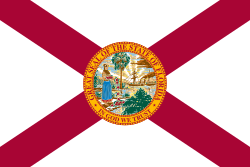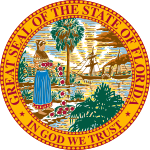
Back Florida AF Florida ALS ፍሎሪዳ AM Florida AN Florida ANG فلوريدا Arabic ܦܠܘܪܝܕܐ ARC فلوريدا ARY فلوريدا ARZ Florida AST
Florida | |
|---|---|
| State of Florida | |
| Nickname: | |
| Motto: | |
| Anthem: "Florida" (state anthem), "Old Folks at Home" (state song) | |
 Map of the United States with Florida highlighted | |
| Country | United States |
| Before statehood | Florida Territory |
| Admitted to the Union | March 3, 1845 (27th) |
| Capital | Tallahassee |
| Largest city | Jacksonville |
| Largest county or equivalent | Miami-Dade |
| Largest metro and urban areas | South Florida |
| Government | |
| • Governor | Ron DeSantis (R) |
| • Lieutenant Governor | Jeanette Nuñez (R) |
| Legislature | Florida Legislature |
| • Upper house | Senate |
| • Lower house | House of Representatives |
| Judiciary | Supreme Court of Florida |
| U.S. senators | Marco Rubio (R) Rick Scott (R) |
| U.S. House delegation | 20 Republicans 8 Democrats (list) |
| Area | |
| • Total | 65,758[5] sq mi (170,312 km2) |
| • Land | 53,625 sq mi (138,887 km2) |
| • Water | 12,133 sq mi (31,424 km2) 18.5% |
| • Rank | 22nd |
| Dimensions | |
| • Length | 447 mi (721 km) |
| • Width | 361 mi (582 km) |
| Elevation | 100 ft (30 m) |
| Highest elevation | 345 ft (105 m) |
| Lowest elevation (Atlantic Ocean[6]) | 0 ft (0 m) |
| Population (2023) | |
| • Total | |
| • Rank | 3rd |
| • Density | 414.8/sq mi (160/km2) |
| • Rank | 7th |
| • Median household income | $57,700[8] |
| • Income rank | 34th |
| Demonym(s) | Floridian, Floridan |
| Language | |
| • Official language | English[9] |
| • Spoken language | |
| Time zones | |
| Peninsula and "Big Bend" region | UTC−05:00 (Eastern) |
| • Summer (DST) | UTC−04:00 (EDT) |
| Panhandle west of the Apalachicola River | UTC−06:00 (Central) |
| • Summer (DST) | UTC−05:00 (CDT) |
| USPS abbreviation | FL |
| ISO 3166 code | US-FL |
| Traditional abbreviation | Fla. |
| Latitude | 24° 27' N to 31° 00' N |
| Longitude | 80° 02' W to 87° 38' W |
| Website | myflorida |
Florida (/ˈflɒrɪdə/ FLORR-ih-də) is a state in the Southeastern region of the United States. It borders the Gulf of Mexico to the west, Alabama to the northwest, Georgia to the north, the Bahamas and Atlantic Ocean to the east; and the Straits of Florida and Cuba to the south. It is the only state that borders both the Gulf of Mexico and the Atlantic Ocean. With a population of over 21 million, it is the third-most populous state in the United States, the most populous among the easterly states, and ranks eighth in population density as of 2020. It spans 65,758 square miles (170,310 km2), ranking 22nd in area among the 50 states. The Miami metropolitan area, anchored by the cities of Miami, Fort Lauderdale, and West Palm Beach, is the state's largest metropolitan area with a population of 6.138 million, and the state's most-populous city is Jacksonville with a population of 949,611. Florida's other major population centers include Tampa Bay, Orlando, Cape Coral, and the state capital of Tallahassee.
Various American Indian tribes have inhabited Florida for at least 14,000 years. In 1513, Spanish explorer Juan Ponce de León became the first known European to make landfall, calling the region La Florida (land of flowers) ([la floˈɾiða]) for its lush greenery and the Easter season (Pascua Florida in Spanish). Florida subsequently became the first area in the continental U.S. to be permanently settled by Europeans, with the settlement of St. Augustine, founded in 1565, being the oldest continuously inhabited city. Florida was a Spanish territory frequently attacked and coveted by Great Britain before Spain ceded it to the U.S. in 1819 in exchange for resolving the border dispute along the Sabine River in Spanish Texas. Florida was admitted as the 27th state on March 3, 1845, and was the principal location of the Seminole Wars (1816–1858), the longest and most extensive of the Indian Wars in U.S. history. The state seceded from the Union on January 10, 1861, becoming one of the seven original Confederate States, and was readmitted to the Union after the Civil War on June 25, 1868.
Since the mid-20th century, Florida has experienced rapid demographic and economic growth. Its economy, with a gross state product (GSP) of $1.4 trillion, is the fourth-largest of any U.S. state and the 16th-largest in the world; the main sectors are tourism, hospitality, agriculture, real estate, and transportation. Florida is world-renowned for its beach resorts, amusement parks, warm and sunny climate, and nautical recreation; attractions such as Walt Disney World, the Kennedy Space Center, and Miami Beach draw tens of millions of visitors annually. Florida is a popular destination for retirees, seasonal vacationers, and both domestic and international migrants; it hosts nine out of the ten fastest-growing communities in the U.S. The state's close proximity to the ocean has shaped its culture, identity, and daily life; its colonial history and successive waves of migration are reflected in African, European, Indigenous, Latino, and Asian influences. Florida has attracted or inspired some of the most prominent American writers, including Ernest Hemingway, Marjorie Kinnan Rawlings, and Tennessee Williams, and continues to attract celebrities and athletes, particularly in golf, tennis, auto racing, and water sports. Florida has been considered a battleground state in American presidential elections, particularly those in 2000, 2016, and 2020.
About two-thirds of Florida occupies a peninsula between the Gulf of Mexico and the Atlantic Ocean. It has the longest coastline in the contiguous United States, spanning approximately 1,350 miles (2,170 km), not including its many barrier islands. Florida has 4,510 islands that are ten acres (4.0 hectares) or larger in area, the second-largest of any state after Alaska. Much of Florida is at or near sea level, and is characterized by sedimentary soil. Florida is the flattest state in the country, with the lowest high point of any U.S. state, at just 345 feet (105 meters).
Florida's climate varies from subtropical in the north to tropical in the south. It is the only state besides Hawaii to have a tropical climate, and is the only continental state with both a tropical climate, located at the southern portion of the state, and a coral reef. Florida has several unique ecosystems, including Everglades National Park, the largest tropical wilderness in the U.S. and among the largest in the Americas. Unique wildlife include the American alligator, American crocodile, American flamingo, Roseate spoonbill, Florida panther, bottlenose dolphin, and manatee. The Florida Reef is the only living coral barrier reef in the continental United States, and the third-largest coral barrier reef system in the world, after the Great Barrier Reef and the Belize Barrier Reef.
- ^ "Florida | Map, Population, History, & Facts". Encyclopedia Britannica. Archived from the original on July 5, 2020. Retrieved June 30, 2020.
- ^ "Florida | State Facts & History". www.infoplease.com. Archived from the original on June 30, 2020. Retrieved June 30, 2020.
- ^ "Florida". www.americaslibrary.gov. Archived from the original on April 27, 2020. Retrieved June 30, 2020.
- ^ "State Motto". Florida Department of State. Archived from the original on January 21, 2016. Retrieved September 14, 2018.
- ^ "United States Summary: 2010. Population and Housing Unit Counts. 2010 Census of Population and Housing" (PDF). United States Census Bureau. September 2012. p. 41. Archived (PDF) from the original on October 19, 2012. Retrieved April 9, 2019.
- ^ a b "Elevations and Distances in the United States". United States Geological Survey. 2001. Archived from the original on October 15, 2011. Retrieved October 21, 2011.
- ^ "U.S. Census Bureau QuickFacts Florida". U.S. Census Bureau, 2023 Estimate. Retrieved January 4, 2024.
- ^ "US Census Bureau QuickFacts". United States Census Bureau. Archived from the original on May 9, 2022. Retrieved April 30, 2022.
- ^ Cite error: The named reference
Article 2, Section 9, Constitution of the State of Floridawas invoked but never defined (see the help page). - ^ "Languages Spoken at Home in Florida". United States Census Bureau. Retrieved January 2, 2022.
- ^ a b "SB 230—State Symbols/Fla. Cracker Horse/Loggerhead Turtle [RPCC]". Florida House of Representatives. Archived from the original on August 19, 2014. Retrieved April 7, 2012.
Cite error: There are <ref group=lower-alpha> tags or {{efn}} templates on this page, but the references will not show without a {{reflist|group=lower-alpha}} template or {{notelist}} template (see the help page).





